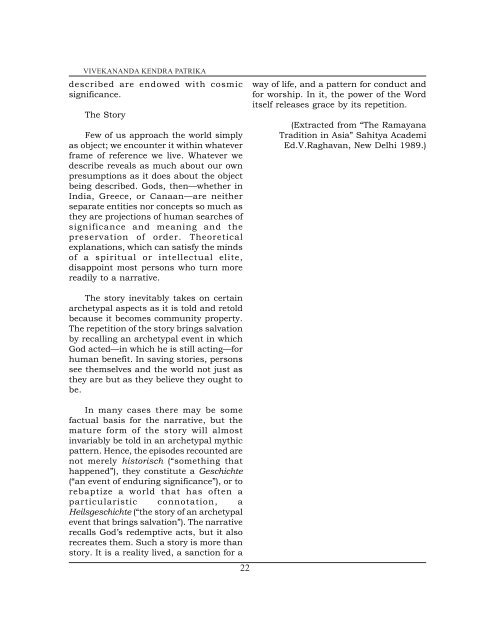Epics in Imprints-1.pdf - Vivekananda Kendra Prakashan
Epics in Imprints-1.pdf - Vivekananda Kendra Prakashan
Epics in Imprints-1.pdf - Vivekananda Kendra Prakashan
You also want an ePaper? Increase the reach of your titles
YUMPU automatically turns print PDFs into web optimized ePapers that Google loves.
VIVEKANANDA KENDRA PATRIKA<br />
described are endowed with cosmic<br />
significance.<br />
The Story<br />
Few of us approach the world simply<br />
as object; we encounter it with<strong>in</strong> whatever<br />
frame of reference we live. Whatever we<br />
describe reveals as much about our own<br />
presumptions as it does about the object<br />
be<strong>in</strong>g described. Gods, then—whether <strong>in</strong><br />
India, Greece, or Canaan—are neither<br />
separate entities nor concepts so much as<br />
they are projections of human searches of<br />
significance and mean<strong>in</strong>g and the<br />
preservation of order. Theoretical<br />
explanations, which can satisfy the m<strong>in</strong>ds<br />
of a spiritual or <strong>in</strong>tellectual elite,<br />
disappo<strong>in</strong>t most persons who turn more<br />
readily to a narrative.<br />
The story <strong>in</strong>evitably takes on certa<strong>in</strong><br />
archetypal aspects as it is told and retold<br />
because it becomes community property.<br />
The repetition of the story br<strong>in</strong>gs salvation<br />
by recall<strong>in</strong>g an archetypal event <strong>in</strong> which<br />
God acted—<strong>in</strong> which he is still act<strong>in</strong>g—for<br />
human benefit. In sav<strong>in</strong>g stories, persons<br />
see themselves and the world not just as<br />
they are but as they believe they ought to<br />
be.<br />
In many cases there may be some<br />
factual basis for the narrative, but the<br />
mature form of the story will almost<br />
<strong>in</strong>variably be told <strong>in</strong> an archetypal mythic<br />
pattern. Hence, the episodes recounted are<br />
not merely historisch (“someth<strong>in</strong>g that<br />
happened”), they constitute a Geschichte<br />
(“an event of endur<strong>in</strong>g significance”), or to<br />
rebaptize a world that has often a<br />
particularistic connotation, a<br />
Heilsgeschichte (“the story of an archetypal<br />
event that br<strong>in</strong>gs salvation”). The narrative<br />
recalls God’s redemptive acts, but it also<br />
recreates them. Such a story is more than<br />
story. It is a reality lived, a sanction for a<br />
22<br />
way of life, and a pattern for conduct and<br />
for worship. In it, the power of the Word<br />
itself releases grace by its repetition.<br />
(Extracted from “The Ramayana<br />
Tradition <strong>in</strong> Asia” Sahitya Academi<br />
Ed.V.Raghavan, New Delhi 1989.)

















